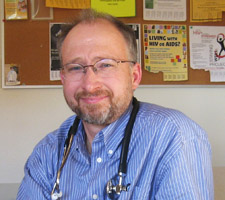These are supposed to be the dog days of summer, but amfAR grantees have had their most prolific month yet, publishing more than a dozen journal articles in July. Several were devoted to HIV cure research.
 amfAR grantee Dr. Steven DeeksDr. Nicolas Chomont of the Vaccine and Gene Therapy Institute in Florida co-authored two reviews in the journal Immunological Reviews. The first, written with two other amfAR grantees, Drs. Steven Deeks and Daniel Douek, addressed the importance of chronic inflammation in facilitating HIV persistence. It focused on the ability of such a process to generate new target cells for the virus to infect, creating a positive feedback loop by which inflammation leads to more virus, and more virus accelerates inflammation. In his second review, co-written with amfAR fellow Dr. Remi Fromentin, Chomont discussed the role of direct cell-to-cell interactions in facilitating viral persistence—a key impediment to a cure.
amfAR grantee Dr. Steven DeeksDr. Nicolas Chomont of the Vaccine and Gene Therapy Institute in Florida co-authored two reviews in the journal Immunological Reviews. The first, written with two other amfAR grantees, Drs. Steven Deeks and Daniel Douek, addressed the importance of chronic inflammation in facilitating HIV persistence. It focused on the ability of such a process to generate new target cells for the virus to infect, creating a positive feedback loop by which inflammation leads to more virus, and more virus accelerates inflammation. In his second review, co-written with amfAR fellow Dr. Remi Fromentin, Chomont discussed the role of direct cell-to-cell interactions in facilitating viral persistence—a key impediment to a cure.
These themes were then expanded upon by Dr. Deeks in conjunction with amfAR researchers Drs. Hiroyu Hatano, Rick Hecht, and Mike McCune. Writing in the Journal of Infectious Diseases, they focused on the contribution of “negative regulators” of T cell activation, particularly PD-1, a protein that has been found in greater concentration on the surface of latently infected cells. Hatano and associates examined 190 HIV-positive individuals whose viral loads were well controlled by antiretroviral therapy (ART).  amfAR grantee Dr. Mike McCuneThey found that the size of the HIV reservoir was related to the presence of markers of immune activation, including the expression of PD-1. This was particularly true for those individuals burdened by low CD4+ T cell counts despite good viral control by ART. They concluded that “HIV infection in these individuals may be more difficult to cure and may require unique interventions.”
amfAR grantee Dr. Mike McCuneThey found that the size of the HIV reservoir was related to the presence of markers of immune activation, including the expression of PD-1. This was particularly true for those individuals burdened by low CD4+ T cell counts despite good viral control by ART. They concluded that “HIV infection in these individuals may be more difficult to cure and may require unique interventions.”
Suggestions as to what those “unique interventions” might be came from an unusual source: studies of the intestinal contents of HIV-positive individuals. Writing in Science Translational Medicine, Drs. Deeks, McCune, and colleagues found that alterations in the normal bacterial content of the gut—specifically an increase in Proteobacteria and a decrease in Bacteroidia—were strongly linked to the disruption of intestinal barriers, leading to chronic inflammation. They concluded that antibiotics, probiotics, and prebiotics—all shown to play a role in facilitating immune recovery in monkeys infected with SIV, the simian equivalent of HIV—might be useful supplements to ART in such cases.
ARCHE grantees Drs. Robert and Janet Siliciano reviewed a two-pronged strategy for HIV eradication that involves reactivating latent virus followed by the killing of infected cells. Beyond the challenges of finding safe and effective drugs that can achieve both arms of this approach, the Silicianos remind us in their Current Opinion in HIV and AIDS article that we need better tools to measure and predict the effects of any intervention before we can confidently proceed to clinical trials and fully assess their outcomes. Despite much progress made in recent years, they conclude that “significant practical challenges must be overcome before HIV-1 eradication can become a reality on a wide scale.”
Dr. Laurence is amfAR’s senior scientific consultant.